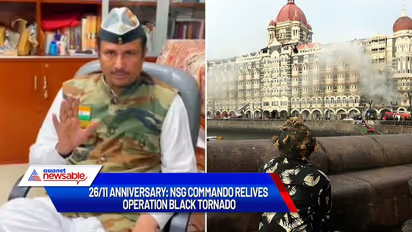26/11 Mumbai Attacks: Ex-NSG commando relives Operation Black Tornado 13 years later

Synopsis
Asianet Newsable reached out to former NSG commando Surender Singh who was part of Operation Black Tornado and was instrumental in taking out two of the terrorists with his MP5 assault rifle.
When terrorists launched strikes at multiple locations in India's financial capital Mumbai on the night of November 26, 2008, the Indian armed forces launched Operation Black Tornado to eliminate the threat. During the 60-hour operation, nine terrorists were neutralised while one was caught alive by the Mumbai Police and hanged for his crime years later.
On the 13th anniversary of the terror attacks in Mumbai, Asianet Newsable reached out to former NSG commando Surender Singh who was part of Operation Black Tornado and was instrumental in taking out two of the terrorists with his MP5 assault rifle. Here's his account of how the operation was planned and executed.
What were the first thoughts that came to your mind when you were told that you were going on a mission to Mumbai?
Firstly, we got information about the Mumbai terror attacks from television. To deal with such a situation, there was only one force in India: the National Security Guard's Special Action Group. The NSG gets training to deal with such situations. The NSG commandos are always prepared 24/7 to safeguard our motherland.
Also Read: 26/11 Mumbai attacks: 13 years on, India's terror dossiers gather dust in Pakistan
How was the Taj operation planned and executed?
We boarded the aircraft from Delhi. The strategy was prepared within the aircraft en route to Mumbai because the terrorists were killing the innocents in the city. It was unwise to deboard the aircraft and formulate a strategy. So we used our flying time in making the plan. We were dropped over Nariman Point, Taj Hotel, and other places using helicopters from the airport.
In the aircraft, we were told that we do not have any concrete information about the number of terrorists other than where they are carrying out their actions. We did not have the layout of the hotels too. The way we were trained in the NSG, we had the confidence, and with that confidence, we conducted our operations.
Watch: Terror Decoded: Pakistan-bred menace Lashkar-e-Taiba
We were told that operations needed to be carried out with individual wisdom and that the priority was to save the lives of innocents and eliminate the terrorists. In the operations, we also suffered casualties, but we saved 627 people, including foreigners. I killed two terrorists.
How were you injured during the 26/11 operation?
The operation continued till November 29. We lost our Major (Sandeep Unnikrishnan). We were searching all the rooms one by one and rescuing the people who were stranded there. After searching three-four rooms, we heard the opening of a door. Within seconds, the terrorist threw a grenade on me. So I jumped from the second floor and took a position in a bar. I saw there was a storage room. So I thought no one could come into this area, and I shut the door.
Also Read: The 60-hour-siege that kept India on tenterhooks
Our team members threw a grenade inside a room where a terrorist was hiding. The terrorist also jumped into the bar. Our team members and I neutralised him. After some time, two more terrorists took a position in the bar, and the firing between us continued for two to three hours. My ammunition was running short. I had made up my mind that I would attain martyrdom but kill these terrorists along with myself. I was planning to attack using grenades. But my team members came in for rescue from the rear door after breaking a wall. In the process, I received splinter injuries on my hands and legs. I got a hearing problem due to the high-frequency blasts.
From where I was engaging with these two terrorists, two commandos were deployed to take them down. My senior adopted all measures to motivate me, saying, 'you are a jawan of grenadier and grenadiers are brave'. 'You are a Jat, and Jats are very strong. They have created history in the world'. I went in there again because I knew their position. I threw two grenades and dominated the position, jumped on top of the bar table under which they had taken position and opened fire. I killed them with my MP5 (weapon).
I got a splinter hit in my leg in that operation, and my shoe was filled with blood. I was admitted into the hospital and was discharged in December end. My treatment had been going on for 3-4 days, and even then, I could not recover. I had a hearing problem. Then I was sent on pension after a medical board. I fought another war to get my pension. I got the pension after a 19-month battle.
Also Read: 26/11 Mumbai terror attacks: How secure is India's 7516km coastline 13 years later
Is the country better prepared to stop another 26/11 from happening?
This government is ready to give a befitting reply now. This (Narendra Modi) government is firmly standing with the forces. During the 26/11 attacks, all three forces were ready to attack Pakistan, but the Manmohan Singh government did not take the step.
Watch this interview
Stay updated with the Breaking News Today and Latest News from across India and around the world. Get real-time updates, in-depth analysis, and comprehensive coverage of India News, World News, Indian Defence News, Kerala News, and Karnataka News. From politics to current affairs, follow every major story as it unfolds. Get real-time updates from IMD on major cities weather forecasts, including Rain alerts, Cyclone warnings, and temperature trends. Download the Asianet News Official App from the Android Play Store and iPhone App Store for accurate and timely news updates anytime, anywhere.